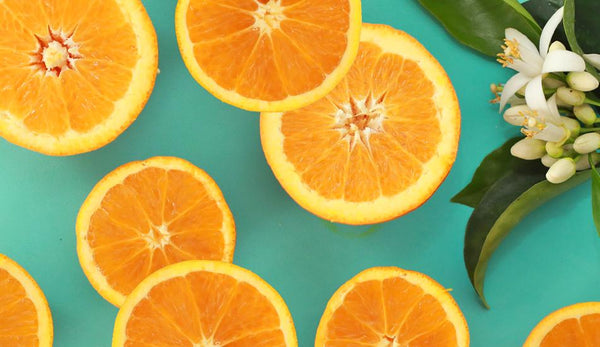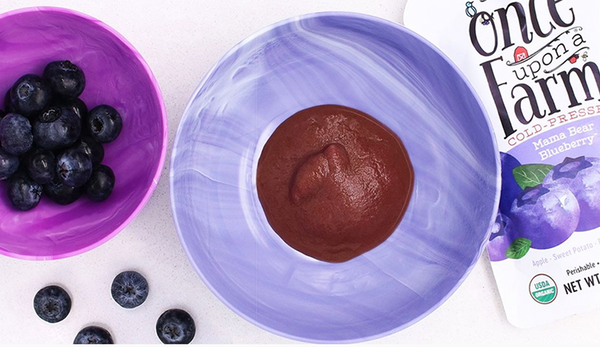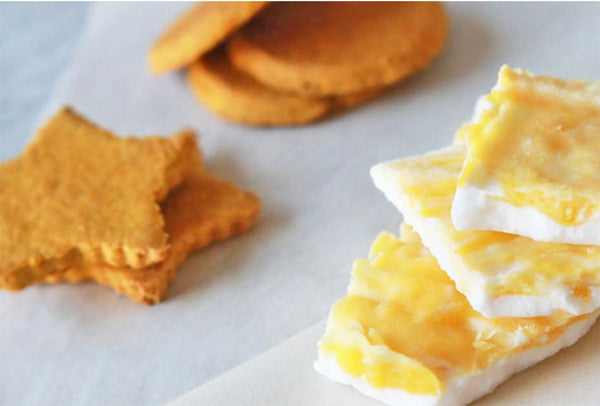Shelf-Stable Baby Food 101

I’ve always been into nutrition. When I had my first daughter about 5 1/2 years ago, I knew I wanted to feed her the very best food possible. I decided I would work outside the home, finish a Ph.D. program, be a full-time mom, and make all her own food. (Oh and don’t forget, try to maintain friendships, a marriage and also have time for some self-care?) No problem right?
Boy was I wrong! Not only did showers and makeup become a rare occasion, trying to realistically make all her own food did as well. So long were the attempts at washing, peeling, chopping, storing, blending, pouring, freezing….then to have things go bad and start all over. Ayayay. Plus, it was a mess to try and dethaw the food at the right time with everything else going on in my schedule.
So I caved. I found myself at the supermarket buying the shelf-stable brands because that was all that existed at the time. (I could find refrigerated pet food and refrigerated adult food, but NO refrigerated baby food! (Still hard to believe). I felt somewhat guilty with each spoonful I gave of those organic baby food pouches. Sure, there are many worse things you could feed your kiddo but I knew there was something “off” about food that was able to sit on the shelf for longer periods than the age of my baby eating it. Food is supposed to go bad. But at the time I was desperate and the time and extra sanity I gained felt worth the trade.
Thus, Once Upon a Farm was born with its seedling beginnings back in 2013. I decided there had to be a better way. If I was wanting fresh, convenient options, there must be more moms that do as well right? So I put my knowledge of HPP, childhood development, nutrition, and extreme passion and perseverance together and I started as a local brand in the San Diego area and was in markets across the county. It is so exciting that we are now able to offer fresh baby food on a national level!
Through the process of diving into a baby food business full time, I’ve learned a thing or two about shelf-stable baby food. Some of the things I have discovered are even more alarming than I intuitively thought they were back in 2013.
Here is what I’ve learned about the shelf-stable baby food industry and what you might be interested in knowing as well:
Note: There is NO shame in feeding your kids shelf-stable options. It surely is not going to kill them and as I mentioned earlier, there are FAR worse things you could be feeding your baby: i.e. diet soda and twinkies (sadly I have actually seen this happen). I do believe that the thermal pasteurization process that shelf-stable food requires, kills and denatures a lot of the nutrients and benefits of the fresh food though. If you want the freshest, most nutrient- dense baby food there is, there is no question that making it yourself or buying an HPP brand is the way to go. You can taste and see the difference yourself, but if you can’t feed your baby these options for whatever reason, trust me, they will live.

SHELF-STABLE BABY FOOD 101
-
Larger baby food companies often start out with pre-processed purees and/or concentrates.
What are pre-processed purees and concentrates? Fruits and vegetables are cut up and are washed through a “food based” chemical wash. They are then milled down into a pulp using extremely powerful machines that raise the temperature of the fruit and vegetable. From there the now “puree” is “defibred”, taking out many important and insoluble fibers that are critical for slow blood sugar absorption and satiety cues. Then it is passed through an extractor to remove even MORE fibers, seeds, particles, etc. The now “substance” then goes through a deareation process removing oxygen and vital enzymes that are critical for nutrient absorption and breakdown. Finally, the substance gets pasteurized over 185 degrees Fahrenheit, killing more vital enzymes, vitamins, and healthy bacteria that are critical for babies’ healthy growth and development. The puree is then passed through ANOTHER filter before it is poured into large plastic drums and can now sit in a shelf-stable environment due to the deactivation of enzymes and the pasteurization process.
Concentrates take the puree process even further. Prior to pasteurization the substance is then sent to an “evaporator” which removes the precious water from the fruit and basically leaves you with sugar (even more sugar than the original purees already leave you with!)
Fruit and Vegetable Pureeing Process Chart

-
Shelf-stable baby food manufacturers will then import these purees into their manufacturing facilities.
Sometimes you can get them in the United States but often they are sourced abroad as they can be cheaper (ever wonder why baby food is so cheap?). Once they are imported they can easily mix the purees together to create different flavors such as those “yummy”, “Apple”, “Pear” and “Broccoli” flavors I’m sure you have all seen.
-
From here some extra things may be added such as lemon juice concentrates (see concentrate process above), citric acid and/or ascorbic acids, and waters.
The reason for this is it brings the PH down to a certain level so mold, bacteria, or pathogens don’t grow in the food. Citric acid and ascorbic acid go through an entire separate level of multi-extractions and could be its own blog but I’ll at least give you a short insight into how citric acid is produced: basically a fungus called “Aspergillus niger” (a disease that causes black mold) is fed onto a sugar containing medium. After the mold is filtered out of the resulting solution, citric acid is isolated using other chemicals and then finally extracted using sulfuric acid. To put it in a nutshell it is a lot of processing that just isn’t necessary and I’d prefer to not have my baby it eat.
-
Once the concoction is mixed together it is poured into pouches made of plastic and aluminum packaging or poured into glass jars.
For now, I’ll talk about the “retort process” which is done with pouches. Now comes the fun part (can you tell I’m being sarcastic?). These pouches, that are made of plastic and aluminum and are filled with all of the pre-processed substances I just mentioned, are heated to 230-275 degrees farenheit! This kills the Vitamin B1 in the product (a critical nutrient for brain development and motor function. In fact, studies have found that without it, it severely affects motor function when babies get to preschool age). The heating process also kills and damages other important vitamins and nutrients such as Vitamin C, Folate, B-6, B-5 (critical to red blood cell development), and Vitamin A. In addition to these critical vitamins, additional enzymes and healthy bacteria are also killed in the process. But that’s not all….
-
The fact that the product loses vitamins and nutrients is definitely an issue, especially if the majority of what babies are eating, are the shelf-stable items.
However, a bigger concern of mine is the fact that they are heated to such high temperatures in plastic and aluminum packaging. Although baby items are mandated to be BPA free, this does not mean much. There are other chemicals inside the plastic such as BPS and other endocrine disruptors which get released during the heating process. BPS has been show to create a slew of health issues such as ADHD, diabetes, obesity, asthma, birth defects and cancer.
-
The pouches are now ready to go and are packed away in boxes and shipped to store shelves where they can sit there for 2 or more years.
-
Now baby gets to eat this “baby food” which tastes super sugary, has no texture, and is lacking vibrancy and color.
-
Babies usually love the food because it tastes very sweet and has a high “BRIX level” (the measure of how sweet something is).
The reason they taste so sugary is because they have been heated several times, condensing the product down into simple sugars, which is basically like a jam.
So now you know a little more about the shelf-stable baby food process. The alternative is to make your own food at home so you know exactly what your baby is getting or to use a baby food that is cold-pressured.
With Once Upon a Farm, our process is simple:
Work with farmers —> Use Fresh Produce —> Cold-Blend —> Cold Fill into pouches —> Run through HPP (a big water pressure chamber that uses NO heat and does not destroy critical nutrients). For more info on HPP visit our blog here: http://www.uponafarm.com/babyfood/
You can taste and see the difference yourself. Try our Magic Velvet Mango and compare that to a Fresh mango vs. a shelf-stable mango and tell us what you think in the comments! We would love to hear from you.
– Written by Cassandra Curtis, Founder & COO, Once Upon a Farm
Cassandra is a mother of two girls Divinaka, age 5 and Skyla age 18 months. She lives in San Diego with her husband, 2 daughters (soon to be 3!), 2 cats and dog. Cassandra works full time as the co-founder and COO (still wearing many hats) of Once Upon a Farm and as a mom. In her rare free time, she loves to do Yoga (she is a certified yoga teacher), cook healthy meals, run, travel, and spend time with friends and family.

References:
- http://www.cobell.co.uk/index.php?page=56
- http://www.oregonfruit.com/fruit-brewing/category/aseptic-advantage/advantages-of-aseptic-purees
- https://datatrace.mesalabs.com/2014/09/22/retort-sterilization-in-food-processing/
- https://en.wikipedia.org/wiki/Citric_acid
- http://onlinelibrary.wiley.com/doi/10.1111/mcn.12397/abstract
- https://www.scientificamerican.com/article/bpa-free-plastic-containers-may-be-just-as-hazardous/
- Scott Belcher, Ph.D., associate professor, pharmacology, University of Cincinnati; Steven Hentges, Ph.D., executive director, polycarbonate business unit, American Plastics Council; Kirby Donnelly, Ph.D., department head, environmental and occupational health, Texas A&M School of Rural Public Health, College Station; Jan. 30, 2008, Toxicology Letters
Read More

Immune Boosting Foods
As many of us are spending more time at home...

Using Purees for Baby-Led Weaning
We’re so excited to partner with Whole Mamas for an...

Homemade Teething Biscuits & Frozen Yogurt Bites
Teething Biscuits Ingredients 2 cups of thick rolled oats 1...
